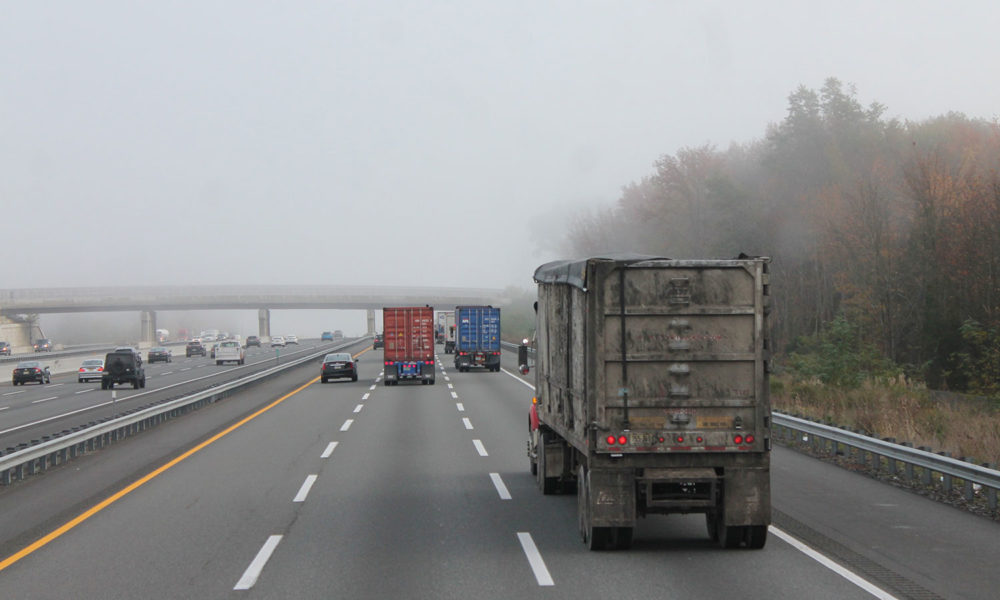Transitioning New Jersey’s diesel trucks to zero tailpipe emission vehicles is a crucial step in making the air safer to breathe in communities across the state, slowing the frightening effects of climate change, reducing truck fleet costs, and providing well-paying jobs. The state is beginning to take the lead by considering several key regulations: the Advanced Clean Trucks Rule and the Heavy Duty Low-NOx Omnibus, though these are necessary but not sufficient steps towards a future with clean air for all. A new analysis shows that these regulations in New Jersey wouldn’t just help clean the air but would also have significant benefits for public health and New Jersey’s economy.
Transportation and other mobile sources contribute significantly to the state’s air pollution, including 79% of NOx and 23% of PM2.5 emissions (smog-forming and soot pollutants) in 2017. This pollution impacts the health of every New Jerseyan, but is especially dangerous around highways, freight corridors and ports where low-income communities and communities of color often bear the greatest burden. The transportation sector is also the largest contributor (42%) to NJ’s share of global warming emissions, the impacts of which include increased flooding in south Jersey and along the coast and acute heat stress and further worsening air quality especially in urban areas. The devastating effects and human toll of Hurricane Ida in New Jersey bear the clear fingerprints of climate change, and as First Lady Tammy Murphy agrees, shows that we need just and equitable climate action now.
Though diesel trucks and buses make up a small proportion of vehicles on New Jersey roads overall, they contribute a disproportionately large amount of air pollution. What’s worse, they are driven longer distances, have longer vehicle lifetimes, and release especially high levels of NOx and PM2.5. The pandemic has shown how much we rely on the movement of goods via truck. This should not and need not result in an unending increase in hazardous diesel pollution.
Why is the exhaust from diesel truck tailpipes so dangerous?
You may often see black soot billowing out of a truck’s tailpipe following its distinctive roar, but the most harmful pollutants of diesel exhaust are often invisible. Diesel engines work by compressing fuel and air within the cylinder until they ignite at very high temperatures, repeatedly pushing the pistons that power the vehicle. In the chemically complex combustion process, nitrogen in the air is oxidized into various forms of harmful NOx, and various carbon particles are released as fine particulate matter (PM2.5). NOx can further react with other chemicals in the air to produce more PM2.5 and ground-level ozone (smog).
PM2.5 are particles at least 20 times smaller than the diameter of fine human hair—small enough to bypass many of our bodies’ natural defenses and penetrate deeply in our lungs. Studies by public health professionals including the Harvard T.H. Chan School of Public Health show that even though national standards are in place, no level of fine particulate pollution is safe to breathe. PM2.5 is also the largest environmental risk factor in the US, and accounts for 95% of global public health impacts from air pollution.
The COVID-19 pandemic and nationwide protests for racial justice have spotlighted how air pollution intersects with other social determinants of health. The systemically unequal distribution of air pollution in the US is cited as a reason for increased COVID-19 mortality among communities of color and low-income communities.
If you add it all up, you can see just how much the cards are stacked against particular NJ communities. For example, Newark has been the site of decades-long histories of racist redlining, white flight, and public disinvestment. More recently, the city has been one of the hardest hit spots of the pandemic in NJ, exacerbated by some of the highest asthma rates in the country (one in every four children) associated with the port and associated diesel truck traffic.
The current moment poses an opportunity to correct course—saving lives and allowing all communities to breathe more freely.

Policymakers are starting to address the issue, with much more to be done
Fortunately, battery and fuel cell trucks avoid the tailpipe emissions of diesel trucks and are increasingly available. Coupled with clean energy, it is clear that 100% electrification of truck fleets is the future. However, strong policies at the state, city, and neighborhood levels are all necessary for a rapid and equitable transition, with major implications for people’s everyday lives.
This April, New Jersey took one step by becoming the first state outside of California to signal strong interest in adopting the Advanced Clean Truck (ACT) Rule, which if adopted will require an increasing percentage of trucks sold to have zero emissions starting in model year 2025. For context, New Jersey has a goal of 100% clean energy by 2050, and signed onto a multi-state Memorandum of Understanding to increase electric medium- and heavy-duty vehicle sales 30% by 2030 and 100% by 2050. Standards like the ACT are concrete steps towards meeting these goals on a state level—leading to both climate and health benefits.
To dive deeper into these benefits, UCS and NRDC worked with MJ Bradley & Associates to study the health, climate, and economic effects of the ACT rule and Low-NOx Omnibus in New Jersey (see summary brief and report), and found some of the key benefits to be:
- Replacing more than 270,000 pollution-emitting diesel trucks and buses with ZEVs by 2050 (or 59% of the in-use fleet).
- Saving fleet owners nearly $420 million annually by 2050, from savings on fuel and maintenance costs.
- Reducing the annual electricity bill of the average New Jerseyan in 2050 by $14 and the average commercial customer by $60 as excess utility revenues from ZEV truck fleets are returned to all utility customers.
- Improving public health, by avoiding nearly 230 premature deaths, 250 hospital admissions and emergency room visits, and 136,000 respiratory-related illnesses and reduced activity and workdays.
- Delivering societal benefits of $11.6 billion from 2020 to 2050, including public health benefits, avoided social costs of carbon, and fleet-owner and utility-customer savings.
The analysis further shows that even quicker deployment of zero emission trucks and buses through other clean truck policies would lead to more of these climate, health, and economic benefits.
These rules are a necessary first step but leave much more to be done. The state needs to take the lead from communities most impacted by truck pollution, and work towards developing solutions to guarantee emissions reductions in overburdened communities. The quest for meaningful community engagement must go beyond public meetings and comments and give communities a seat at the decision-making table.
Cleaning up New Jersey’s diesel trucks will go a long way in shaping a modern, sustainable, and equitable transportation system with clean air for all.

